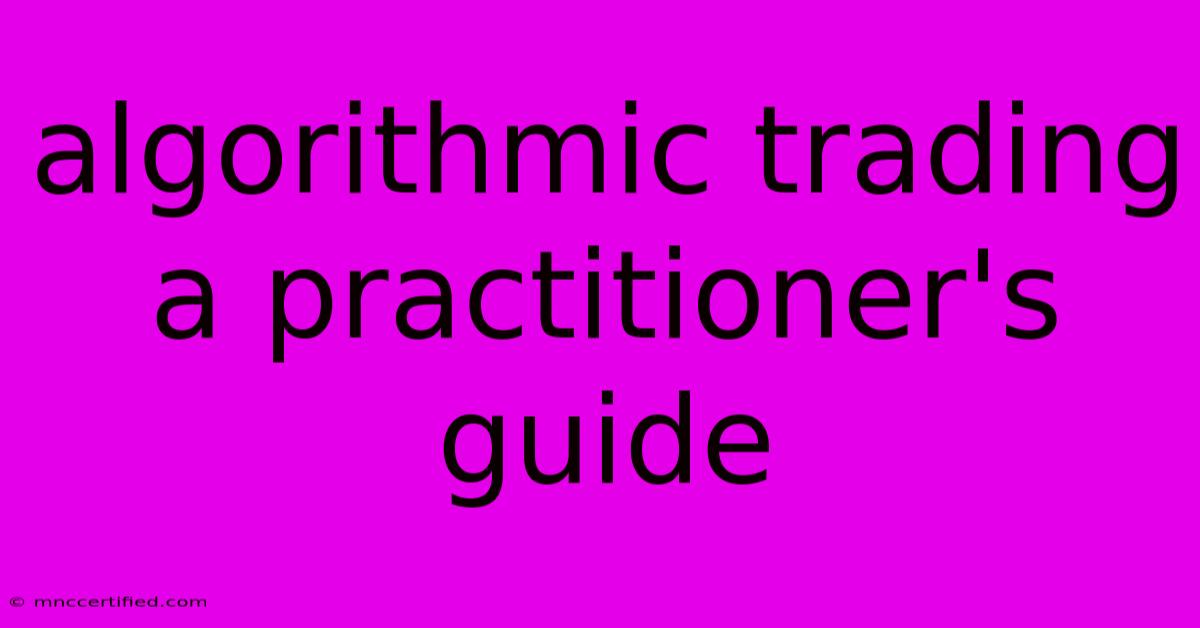Algorithmic Trading A Practitioner's Guide

Table of Contents
Algorithmic Trading: A Practitioner's Guide to Mastering the Markets
The world of finance is constantly evolving, with technology playing an increasingly crucial role. One such advancement is algorithmic trading, a revolutionary approach that leverages computer algorithms to execute trades automatically. While this technology offers significant potential for improved efficiency and profitability, it's not without its challenges. This guide provides a comprehensive overview of algorithmic trading, exploring its intricacies, benefits, and practical considerations.
What is Algorithmic Trading?
Algorithmic trading involves using pre-programmed instructions to execute trades based on specific market conditions. These algorithms analyze vast amounts of data, identify trading opportunities, and trigger transactions at lightning speed, surpassing human capabilities in terms of speed and precision.
Key Features of Algorithmic Trading:
- Automated Execution: Algorithms execute trades automatically, eliminating human error and emotional biases.
- High-Frequency Trading: Some algorithms can execute thousands of trades per second, capitalizing on fleeting market opportunities.
- Data-Driven Decisions: Algorithms rely on data analysis to identify patterns and make informed trading decisions.
- Backtesting and Optimization: Algorithms can be tested against historical data to assess their performance and optimize trading strategies.
Advantages of Algorithmic Trading:
- Speed and Efficiency: Algorithms execute trades faster than humans, allowing traders to capitalize on fleeting opportunities.
- Reduced Emotion: Eliminating human emotion from the trading process minimizes impulsive decisions and reduces risk.
- Scalability: Algorithms can handle vast amounts of data and execute multiple trades simultaneously, making it ideal for managing large portfolios.
- Backtesting and Optimization: Algorithmic strategies can be tested and refined based on historical data, leading to improved performance.
- Reduced Transaction Costs: Automated execution can lead to lower brokerage fees and slippage.
Types of Algorithmic Trading Strategies:
- Trend Following: Identifies and exploits price trends in the market.
- Mean Reversion: Capitalizes on price fluctuations around a specific mean value.
- Arbitrage: Exploits price discrepancies between different markets or instruments.
- High-Frequency Trading (HFT): Uses sophisticated algorithms to execute a massive number of trades at extremely high speeds, often based on tiny price fluctuations.
- Market-Making: Provides liquidity to the market by placing buy and sell orders simultaneously.
Building an Algorithmic Trading System:
Step 1: Define Your Strategy: Clearly articulate your trading goals, risk tolerance, and market focus.
Step 2: Data Acquisition: Secure reliable and high-quality market data, including historical price data, news feeds, and economic indicators.
Step 3: Algorithm Development: Select a suitable programming language (Python, R, MATLAB) and develop your trading algorithm.
Step 4: Backtesting and Optimization: Thoroughly test your algorithm against historical data to assess its performance and identify areas for improvement.
Step 5: Live Trading: Deploy your algorithm on a live trading platform, monitor its performance, and adjust as needed.
Challenges and Considerations:
- Technical Complexity: Developing and maintaining sophisticated trading algorithms requires specialized skills and knowledge.
- Market Volatility: Algorithmic trading is sensitive to market fluctuations and can be susceptible to sudden price movements.
- Regulation and Compliance: Trading algorithms must comply with relevant regulations and legal requirements.
- Ethical Concerns: There are concerns about the potential for algorithmic trading to exacerbate market volatility and create unfair advantages for certain participants.
The Future of Algorithmic Trading:
Algorithmic trading is expected to play an increasingly significant role in the financial markets. Advancements in artificial intelligence, machine learning, and big data analytics will continue to drive innovation and enhance the capabilities of trading algorithms.
Key Trends to Watch:
- Artificial Intelligence (AI): AI algorithms can learn and adapt to changing market conditions, improving trading strategies.
- Machine Learning: Machine learning algorithms can identify patterns and anomalies in vast datasets, improving trading decisions.
- Cloud Computing: Cloud-based trading platforms provide scalability and access to powerful computing resources.
- Blockchain Technology: Blockchain technology can enhance transparency and security in trading operations.
Conclusion:
Algorithmic trading offers significant potential for improving trading efficiency and profitability. However, it's important to approach this technology with caution and a thorough understanding of its complexities, risks, and ethical implications. By carefully considering the advantages and challenges of algorithmic trading, practitioners can leverage its power to navigate the dynamic world of finance.

Thank you for visiting our website wich cover about Algorithmic Trading A Practitioner's Guide. We hope the information provided has been useful to you. Feel free to contact us if you have any questions or need further assistance. See you next time and dont miss to bookmark.
Featured Posts
-
Request For Proposal Investment Management
Nov 07, 2024
-
Bayern Vs Benfica Kickoff Live Now
Nov 07, 2024
-
Mark Cuban No 1 Billion Loss For Harris Support
Nov 07, 2024
-
Millwalls Japh Four Wins In A Row
Nov 07, 2024
-
Ivanka Trumps Blue Outfit Divides Opinions
Nov 07, 2024